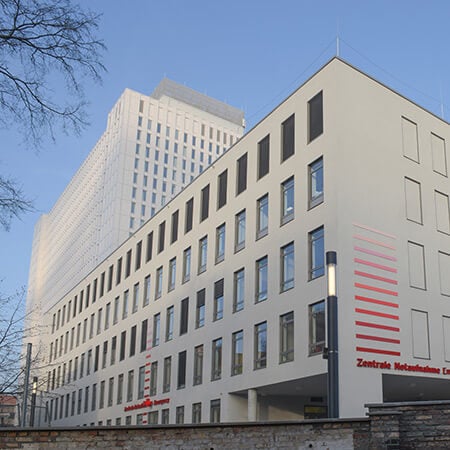Glioblastoma is a malignant brain tumor, which is known for its poor prognosis and low survival rates. The standard treatment protocols offered to most patients in local hospitals proved to be less effective than expected. For this reason, more and more patients are seeking novel therapies and a more comprehensive approach to glioblastoma treatment abroad. The best glioblastoma treatment centers, including those based in Germany, are renowned for their top-notch technologies and highly skilled specialists. Glioblastoma management in these centers helps patients to get access to the latest innovations, winning time, and bringing back hope for recovery.
What is Glioblastoma and Why Do We Need to Choose the Clinic?
Glioblastoma is a type of aggressive brain cancer, which typically evolves from glial cells called astrocytes. It is considered to be the most common and rapidly growing type of brain tumor among adults. Sadly, glioblastoma is known to be the #1 brain tumor with the highest death rates. Survival rates rarely exceed 1.5 years after the initial diagnosis, highlighting the importance of timely and accurate diagnostics.
Technological breakthroughs and the availability of novel medical techniques have improved the precision of diagnostics. For example, 3D and functional MRIs, which are actively used in German clinics, significantly increase chances for an accurate diagnosis and further timely treatment. PET scans accompanied by subsequent proton therapy are opening up new opportunities in the field of teranostic medicine, where diagnostics align with therapy in one session. State-of-the-art technologies, such as intraoperative MRIs and stereotactic guidance, notably improve the safety and survival rates of patients with glioblastoma.
The expertise of doctors is a well-established factor that greatly influences treatment success. Studies showed that patients treated in large, specialized oncology centers by experienced neuro-oncologists and neurosurgeons have higher survival rates and fewer complications. Multidisciplinary teams that include neurologists, radiologists, surgeons, and oncologists are essential for creating an individualized treatment plan destined for success.
Schedule Diagnostics
Novel Therapies for Glioblastoma You Need to Know About
The insufficient response to standard therapy paved the way for medical innovations for glioblastoma. One of the most promising advances is dendritic cell therapy, an individualized type of immunotherapy that harnesses the body's own immune system by programming dendritic cells to recognize and attack tumor-specific antigens. Dendritic cell therapy for glioblastoma has shown encouraging results in extending survival rates, especially when combined with other immunotherapy approaches. In the landmark DCVax-L Phase III trial, patients with newly diagnosed glioblastoma who received dendritic cell therapy had a median survival of 23.1 months, compared to 15.7 months for those in the control group. In addition, over 15% of patients demonstrated a 48-month survival rate, a significant improvement for a disease in which long-term survival is quite rare.
Alongside dendritic cells, CAR-T cell therapy is now being adapted for glioblastoma. Previously successful in hematologic cancers, CAR-T cell therapy is gradually regaining recognition. By targeting specific surface markers, such as EGFRvIII, CAR-T cells can mediate an immune response that eliminates the malignant cells.
Minimally invasive image-guided interventions, including RFA and cryoablation, are getting traction for glioblastoma treatment. These procedures spare healthy tissue while precisely eliminating the tumor. Radiofrequency ablation (RFA) applies localized heat to destroy malignant tissue. It has been shown to be safe when used alongside stereotactic brain biopsy in select glioblastoma cases. RFA may be an option for the early stages of glioblastoma and is also considered after systemic treatments to prevent recurrence.
Cryoablation, which freezes tumor mass via argon-cooled probes, has been shown to be feasible in recurrent glioblastoma. It also has the added potential to stimulate systemic anti-tumor immunity. Therefore, cryoablation is especially beneficial as part of a complex glioblastoma management strategy that includes immunotherapy to enhance its efficacy.
Book a Consultation
How Can Booking Health be of Help?
Patients looking for treatment innovations abroad often search for information online, study multiple forums, and read endless reviews while trying to select the best glioblastoma clinics. However, it is easy to get lost navigating tons of information without solid backup of expertise and experience. Booking Health is a reliable partner that can assist you with the management of your treatment abroad. As a renowned medical operator with more than 10 years of experience, we offer only an individualized, comprehensive approach to selecting the most appropriate clinical program. Having consulted with hundreds of thousands of patients, Booking Health has established direct contacts with the best glioblastoma hospitals in Germany. This allows our patients to avoid long waiting lists and reduce the total cost of treatment. In addition, the Booking Health specialists provide the following services:
- Visa support regardless of your country of origin
- All-inclusive organization of your trip abroad
- Medical review and translation of the documents
- A personal interpreter on-site
- Direct communication with a glioblastoma specialist without no intermediaries
- Personalized programs based on your unique clinical profile
You don't need to look for medical intermediaries to get treatment abroad. Look for a trusted partner who can help you find treatment without letting you down.
Request Consultation with Medical Specialist
How to Get Glioblastoma Treatment Abroad?
Medical innovations do not come around every corner because they are the result of meticulous, time-consuming, and resource-intensive processes centered in major brain oncology hospitals. Many of these facilities are located in Germany, a country that invests immense resources into oncology research and cutting-edge technologies. It may sound like a bad idea to choose an international hospital for targeted therapy or tumor resection because of a number of reasons, ranging from language barriers to logistical issues. Nevertheless, treatment abroad isn't just about receiving a new kind of therapy. It's about finding new life and new hope. Fighting back cancer is possible only if you make an informed, mindful choice of comprehensive approach, which goes beyond by-the-book protocols. The novel approaches and top-notch technologies used in German medical centers not only increase the chances of successful treatment and survival, they also help patients regain hope. Contact Booking Health now to start your glioblastoma therapy and regain a life filled with meaningful days and hope for a better future.
Start Your Treatment Journey
Authors:
This article was edited by medical experts, board-certified doctors Dr. Nadezhda Ivanisova, and Dr. Bohdan Mykhalniuk. For the treatment of the conditions referred to in the article, you must consult a doctor; the information in the article is not intended for self-medication!
Our editorial policy, which details our commitment to accuracy and transparency, is available here. Click this link to review our policies.
Sources:
American Brain Tumor Association
National Library of Medicine
Radiopaedia















